
© 2010-2024 by Fine Arts of the Southwest, Inc. All rights reserved.
Unauthorized reproduction or use is strictly prohibited by law.
A rare and exceptionally fine large-scale
historic Navajo tufa-cast coin silver and Nevada turquoise bracelet, c. 1920’s
ex: Martha H. Struever, Santa Fe, NM
Plainly and simply put, this piece is a true collector’s dream come true. It’s a wonderful old historic Navajo bracelet (of course) but it’s also a magical lens through which to view and learn a fascinating Southwestern history lesson which at once encompasses a deeply historic region and its unique native inhabitants and the different worldview of the several cultures who populated the region during one of the most crucial and eventful periods in its entire long history, from the late 19th Century through the late 20th.
This bracelet is a piece which recalls many of the greatest names of Native American jewelry and other forms of art collecting in the historic Southwest; the renowned Indian traders, archaeologists, ethnologists, curators, enterpreneurs, philanthropists, robber barons, adventurers and enthusiastic tourists who flocked to and explored the many wonders of this spectacular region in rapidly increasing numbers first by train through the Santa Fe Railway/Fred Harvey Company system, on their own via horse and wagon and later by automobile via Route 66.
People such as John Adair, H.P. Mera, Frank Hamilton Cushing, J.L. Hubbell, Fred Harvey, Herman Schweizer, William Haskell Simpson, Charles Elkus, Millicent Rogers, and later teal McKibben, Lauris Phillips, Lynn Trusdell and Martha Struever all built extraordinary collections of historic Southwestern Arts and Crafts during the early to late 20th Century, assembling exceptional accumulations of jewelry, textiles, Pottery, kachina dolls, basketry etc. This bracelet is precisely the sort of prized deeply authentic completely ethnographic dripping with the patina of age and experience type piece they valued so highly and chased after so fervently.
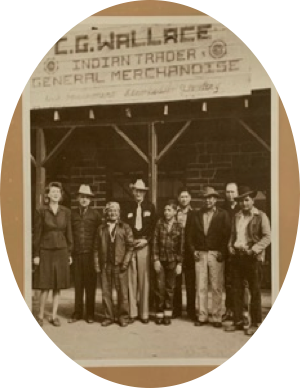
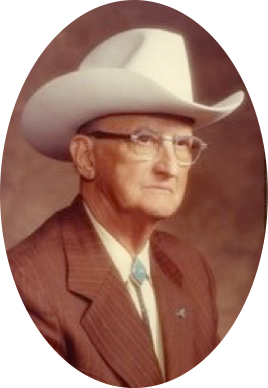
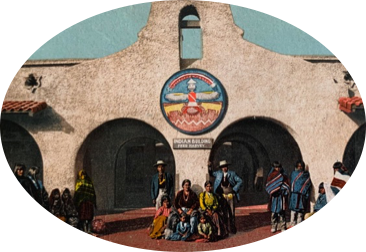
The bracelet we are showing you here could very possibly be an earlier work by this same excellent silversmith, Charles Begay. As can be seen in the side-by-side comparison in the photo above, the overall sensibility of the two pieces; the zoning, chisel and stamp work, silver casting, silver texture and surface and size, shape, type and color
of turquoise stone used are all fairly similar. The later piece is somewhat more complex and more “adorned” as it typically would be given the somewhat later time period in which it was made.
So although we cannot know this for certain, it is well within the realm of possibility, particularly given the possible Charles Begay connection, that this piece could have passed through C.G. Wallace’s hands at some earlier point in the 20th Century. It is the sort of piece that would have appealed greatly to him and to his distinguished clientele. Our direct later knowledge of the provenance and past ownership of this remarkable bracelet is also noteworthy and particularly so in light of our opening discussion here about the great collections and great collectors of Southwestern Arts and Crafts. The bracelet’s last former owner from whose estate we acquired it was the late Grande Dame of the Santa Fe Indian Arts world, the esteemed collector, author, dealer, curator and our longtime friend and former colleague, Martha Hopkins Struever (1931-2017). All things considered, this one is definitely one for the record books!
The bracelet measures 2 1/2” in width at its widest center point and tapers down to 1 3/8” in width at the terminal ends. The inner circumference end-to-end is 5 7/8” and the gap between the terminals is 1 5/16” for a total interior circumference of 7 3/16”. The bracelet weighs an impressive 142 grams or 5 ounces, definitely an old-style heavy-duty Ethnographic armful. Yet, despite its obviously large size and considerable weight, the bracelet is very gracefully and elegantly made and it wears very well and comfortably on the arm. The bracelet is in completely excellent original condition overall, with some age-appropriate wear and a fine original patina.
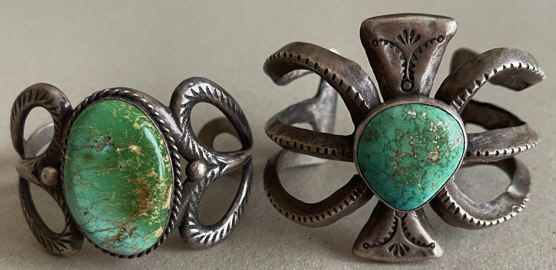
At left, Indian trader C.G.Wallace, c. 1940's, another important person through whose hands this bracelet might have passed. At center left, Navajo tufa-cast bracelet by Charles Begay, c. 1931, almost identical to one listed in the 1972 C.G. Wallace Collection auction at Sotheby Parke-Bernet. At right, C.G. Wallace Trading Post, Zuni, NM c. 1940's.
Left and right photo source and © Sotheby Parke Bernet
Speaking of the stone, let’s talk briefly about the prize teardrop-shaped old mine-cut chunk of turquoise in this baby. It measures a very impressive 1” in length and is also nearly 1” in width. Someone surely paid or traded handsomely, perhaps a few nice fat sheep, to get their hands on this gem. The beautiful, large, greenish-blue old mine-cut turquoise stone is likely from one of the early Nevada mines, most probably the Fox or Blue Gem; these mines along with the Sleeping Beauty in Arizona, the Tiffany/Cerrillos in New Mexico and the Pinto/Watts/Nevada Blue also in Nevada were some of the earliest producing turquoise mines in the country beginning around 1900. The stone also has some similarities to the highly-regarded “Goldenweb” spiderweb turquoise from the old Edgar #8 Mine in Carlin, Nevada which was officially opened in 1923, but unofficially stones were likely coming out of there some years earlier. At the end of the day, the bottom line here is, regardless of which particular mine this stone is from, it’s just terrific.
Most interestingly, we also might have a fairly plausible insight into who the possible maker of this bracelet could have been which is quite unusual as it’s nearly impossible generally speaking to put individual names to such early pieces made so long ago unless they were somehow objectively documented which this one possibly could be by association. As it happens, we have another Navajo tufa-cast silver and turquoise bracelet which is quite similar in a number of ways to this one but is uniquely documented as having been made some years later, circa 1931, by a Navajo silversmith named Charles Begay who was well known as being the maker of several fine pieces owned personally and also sold by the renowned Gallup and Zuni Pueblo, NM Indian Trader, C.G. Wallace (1898-1992). Charles Begay sold several pieces to C.G. Wallace one of which was documented and later sold in the famous C.G. Wallace Collection sale at Sotheby’s in 1972 and the other bracelet we have is virtually identical to that piece. To view our website listing of this other bracelet, please click here.
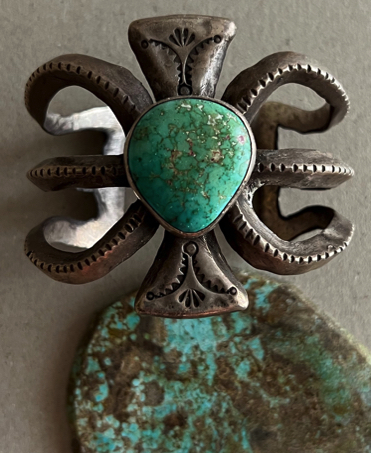
In these early largely pre-commercially oriented days the Navajo generally preferred their jewelry to be made on as large a scale and as heavy as possible and this bracelet delivers on both these accounts in spades. The size, weight and sheer physical presence were culturally meaningful here as a measure of one’s personal, family and clan wealth and prestige, the more big silver you had on you the more important you, your family and your clan were. This was a piece made to impress your friends so to speak and intimidate and heap a pile of shame upon your enemies for not having anything as obviously worthy, beautiful and prestigious as you did.
The silver coins, nearly six American silver dollars worth by weight, which make up the five ounces of silver used to create this bracelet were most difficult and dear to come by in the mostly trade/barter economy of rural and incredibly isolated Navajoland in the early 20th century as they represented hard currency which could be used to buy things which couldn’t easily be bartered for. To put this amount of silver cash money into an appropriate value perspective this amount of hard silver currency in this place at that time was enough to purchase about fifteen pounds of good beef, four dozen eggs and seven loaves of bread, a very serious supply of nutritious provisions in a harsh land of general scarcity.
The unknown Navajo silversmith entrusted to make this bracelet with these exceptionally valuable coins first melted them down and then quickly and precisely poured the red-hot molten silver into a painstakingly hand-carved volcanic tufa stone mold to make the body of the bracelet which he then shaped and fashioned into its final form and skillfully decorated with spare yet lovely chisel, file and stamp work deigns. Finally, as a crowning touch, the beautiful large central turquoise stone was set into its old-style “Foldover” type silver bezel.
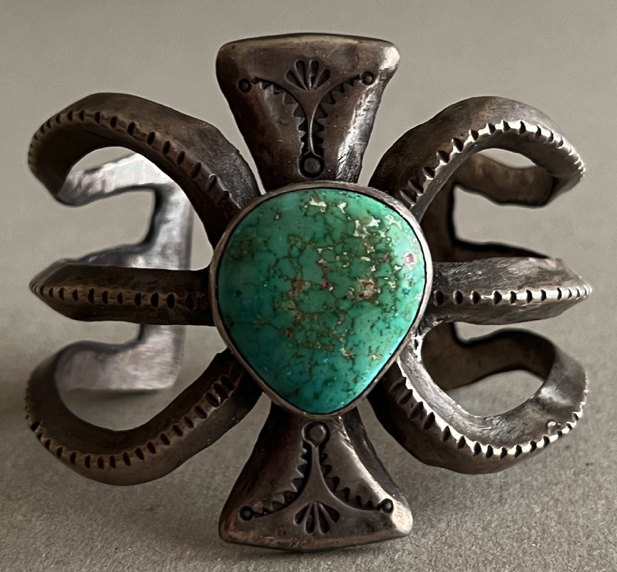
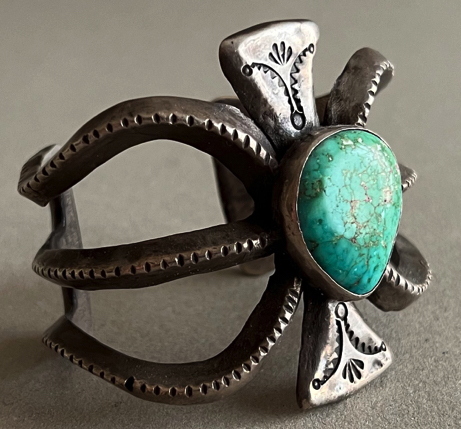
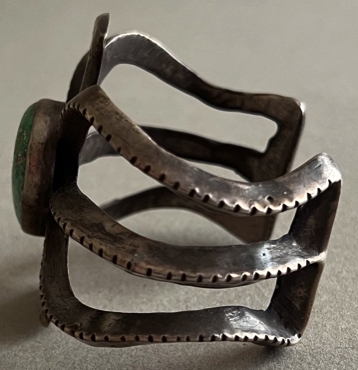
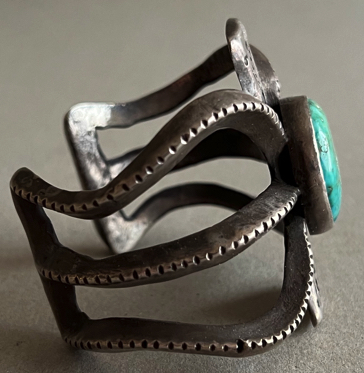
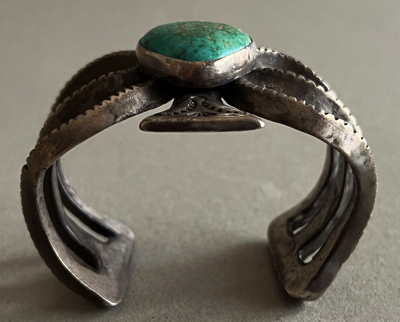
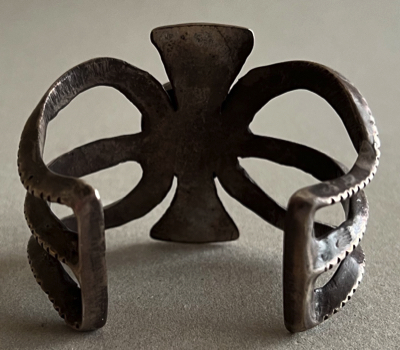
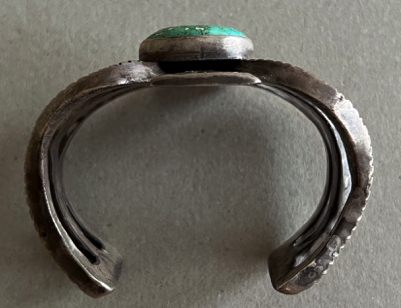
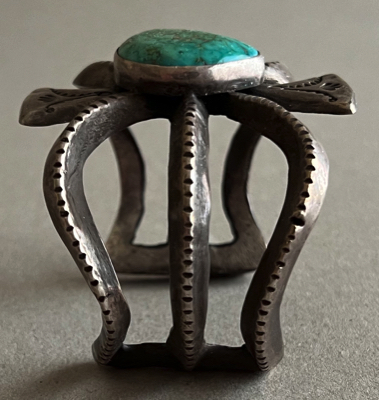
At left, Indian trader J.L. Hubbell, c. 1910. This bracelet could have passed through his hands at his AZ trading post seen above. At right, might this be the bracelet's original owner?
Left and center photo source and © National Park Service.
Right photo source and © John Adair, "The Navajo and Pueblo Silversmiths".
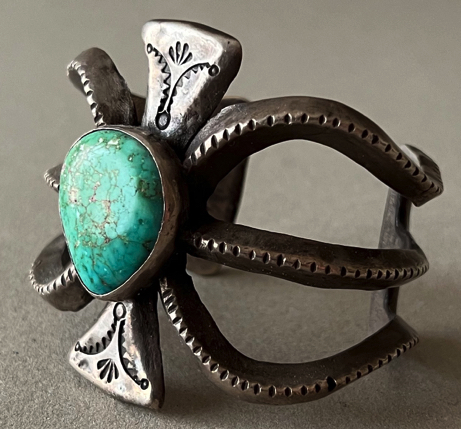
How often and where do you ever see one of these types of pieces available these days? Almost never, and then usually only in Museums, the finest old private collections and perhaps once in a very very blue blue moon still being proudly held in pawn for an old local Navajo family at an old trading post way deep out on the far reaches of the great Navajo Reservation, a longtime historic close-to-the-local-community post such as Shonto, Kayenta, Oljato or Inscription House, the last two of which are unfortunately only still with us in fond memory today.
This incomparable bracelet is a truly great piece of Native American jewelry and so much more, a real and substantial chunk of authentic true Southwestern history and culture, a looking glass back to and enduring memento of a bygone age of extraordinary discovery and wonder. One thing we can pretty much promise you, the next time you see a piece of old Navajo jewelry this good, you’ll probably be standing somewhere like the Smithsonian or The Field Museum looking longingly at it in a glass display case.
Price $4,750
SOLD
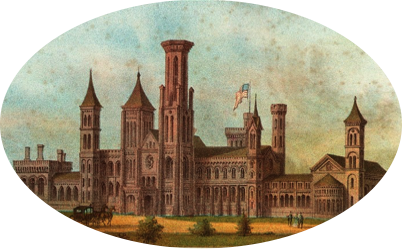
At center, the Fred Harvey Company's famous Indian Building at the Hotel Alvarado in Albuquerque, New Mexico. This bracelet may very well have once been sold there. At left and right, two American museums who might have pieces like this bracelet in their collections; The Smithsonian Institution in Washington D.C. and The Field Museum of Natural History in Chicago.
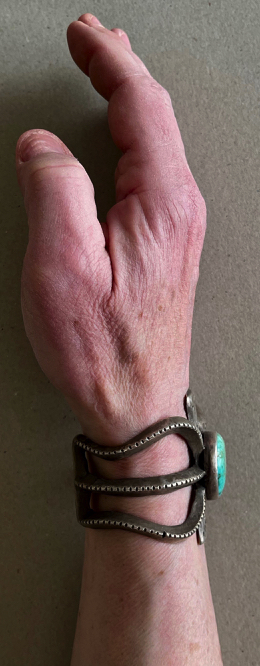
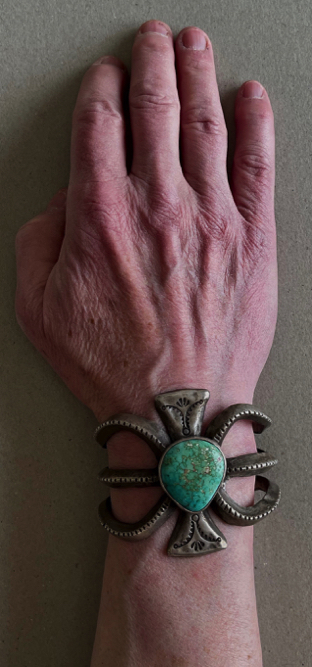
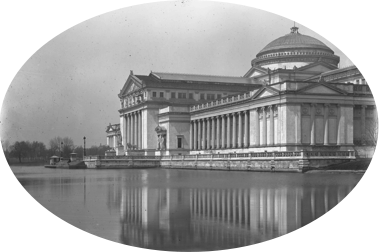
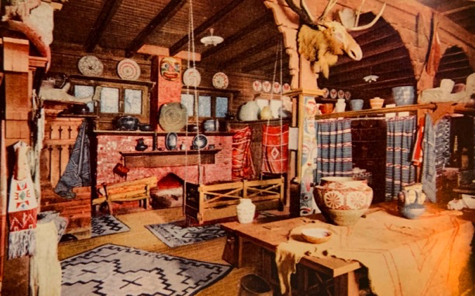
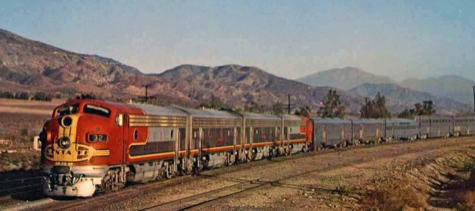
At left, Fred Harvey, whose hotel and trading empire helped introduce the American Southwest to the world. At right, Farona Konopak,
a Fred Harvey Company Indian Detour guide based in Santa Fe. Above center, interior of the Fred Harvey Company's Indian Building at Albuquerque's Hotel Alvarado. Below center, The Santa Fe Railway’s “Super Chief” en route from Albuquerque to Los Angeles.
Left, right and top center photo source and © The Fred Harvey Company. Bottom center photo source and © The Atchison, Topeka and Santa Fe Railway.
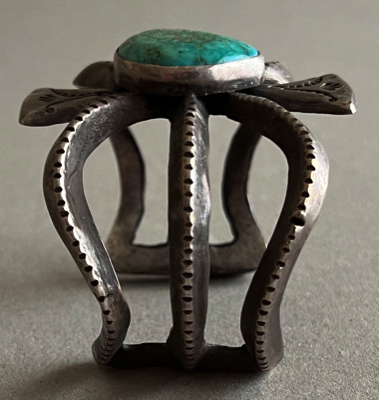
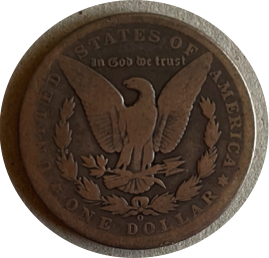
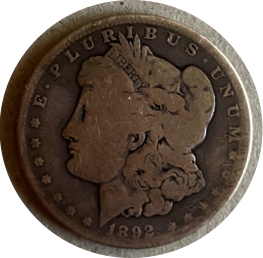
The bracelet pictured with a #8 Mine Nevada "Goldenweb" turquoise rough stone.